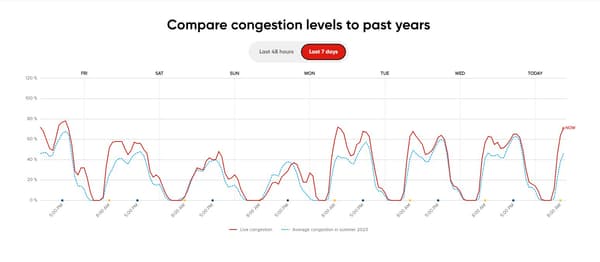This week marks a new stage in traffic restrictions in Île-de-France ahead of the Olympic Games: 185 kilometres of reserved Olympic lanes have been put into service, before the closure of new routes from Thursday 18 July.
If there was no feared chaos on the roads – 280 kilometres of traffic jams at the end of the day on Monday according to Sytadin in the urban area outside Paris, within the city limits the traffic was more complicated according to TomTom.
The GPS specialist launched a new index last week to monitor traffic in real time this summer and during the Paris Olympics and on the ring road. According to this new indicator, the congestion rate remained higher throughout the day than the average for the same day of the week in July and August 2023.
Travel time increased by 72% compared to normal
At 9 a.m. on Monday, the congestion rate had reached 72% (a very high congestion rate), compared to 44% at the same time last year. This means that motorists’ travel time had increased by 72% compared to the perfectly smooth traffic time for the same journey.
A trend that was confirmed in the following days at 9:00 a.m.: 68% congestion in Paris during normal hours on Tuesday, 63% on Wednesday and 71% on Thursday 18 July, i.e. almost 25 points higher than the average.
TomTom does not specify, however, whether this high congestion rate corresponds to fewer lanes and as many cars, or to fewer cars.

Last year, traffic congestion levels decreased in July compared to 10 and 11 July, a trend that does not seem to be confirmed this year. “Compared to July 2023, we are currently consistently above last year’s curve,” sums up Vincent Martinier, spokesperson for TomTom.
Although the road situation in Paris appears to have worsened since the beginning of July, this is not necessarily the case throughout the Île-de-France region.
For BFM Business and BFM Paris, TomTom compared June 2023 and June 2024. On average, across the Greater Paris metropolis, the monthly congestion rate was 39% this year, compared with 46% last year, at the height of protests against pension reform. Traffic, which was difficult last year, remained this year, without deteriorating significantly across the metropolis.
More than doubled travel time on June 6
One date has been particularly emblematic in the last two years in terms of traffic jams: June 6. Last year, in the midst of the pension reform, the 14th day of protest was in full swing with strikes, particularly in the air and rail sectors. The congestion rate in the region then reached 54% (a fairly high rate) for the entire day.
This year, on June 6, amid a visit by US President Joe Biden to France and the accidental closure of the A13, the congestion rate reached 55%, following, in particular, a surprise closure of the ring road.
However, some hours were more tense on June 6, hence perhaps the impression of traffic chaos widely documented on social media by users.
“On June 6 at 9 a.m., the congestion rate was 109% in Île-de-France, meaning that travel times had more than doubled,” explains Vincent Martinier.
He added: “So the traffic in Paris was even heavier.” In total, 1,500 kilometres of traffic jams were recorded in the Greater Paris metropolis on 6 June. An impressive figure, but still lower than that of 18 June.
By 9 a.m., the congestion rate had reached 110%. In total, 1,660 kilometres of traffic jams were recorded during the day, according to TomTom. By 9 a.m., there were more than 600 kilometres of traffic jams, due to heavy rain and the closure of the A13.
Paris, the most congested city in the world?
2023, 2024, the situation remains difficult on the roads of Ile-de-France. Enough to crown Paris as the most congested city in the world, as in May according to this tweet?
“We don’t even notice that Manila is still much more congested in June than Paris, with a congestion rate of 75% compared to 39% in Paris,” Vincent Martinier explains. Bogota in Colombia, Bucharest in Romania and Dublin in Ireland were also on average more congested than Paris last month.
Source: BFM TV


